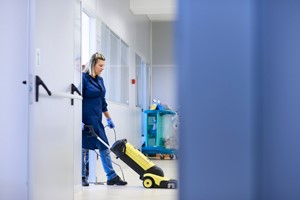Cleaning chemical safety tips

Janitorial, building maintenance, and housekeeping employees regularly use cleaning chemicals to help keep workplaces, public, guest, and other areas clean and sanitary. Some of these chemicals can be hazardous to workers’ health and their use can cause coughing, wheezing, red, itchy eyes, skin rashes, skin and eye burns, shortness of breath, sore throat, headaches, dizziness, nose bleeds, and asthma.
Employers must provide proper training to each employee before they use chemicals. The Occupational Safety & Health Administration (OSHA) recommends the following general safety guidelines for workers who use cleaning chemicals:
• Know the location of chemical Material Safety Data Sheets (MSDSs) in the workplace. Understand the hazards and recommended safety precautions for each cleaning chemical before using it
• Never mix cleaning products that contain bleach and ammonia. Doing so can cause dangerous gases to be released that can harm workers when inhaled
• Take note of which chemicals must be diluted before use and how to properly dilute them
• Check with employers and MSDSs on the proper use, storage, and emergency spill procedures for each cleaning chemical that is used
• Use the proper personal safety supplies for each product. Protective clothing, gloves, respiratory protection, or safety goggles may be recommended when using certain cleaning chemicals
• Make sure all cleaning chemical containers are properly labeled to indicate their contents, hazards, and safety precautions
• Use ventilation systems when necessary to prevent the concentration of hazardous vapors from reaching dangerous levels
• Wash hands after using chemicals and before smoking, eating, or drinking
Employers can also consider providing new equipment that minimizes the use of chemicals, such as microfiber mops, cloths, and dusters, walk-off mats in entryways, high-filtration HEPA vacuums, walk-behind hard floor auto scrubbers, hands-free mops, and chemical-free cleaning systems.
Many employers are choosing to further protect workers by providing green cleaning products that may be safer to use. Green cleaners are products that are certified by independent organizations as less hazardous to workers and the environment. It is important to note that the MSDSs for these chemicals should be consulted before they are used in the workplace as protective equipment may still be suggested.
Schools, hospitals, day care centers, food service operations, factories, office buildings, and many other workplaces use cleaning chemicals that can be hazardous. Practice safety first to ensure work crews are equipped with the proper protective equipment, knowledge, and procedures.



